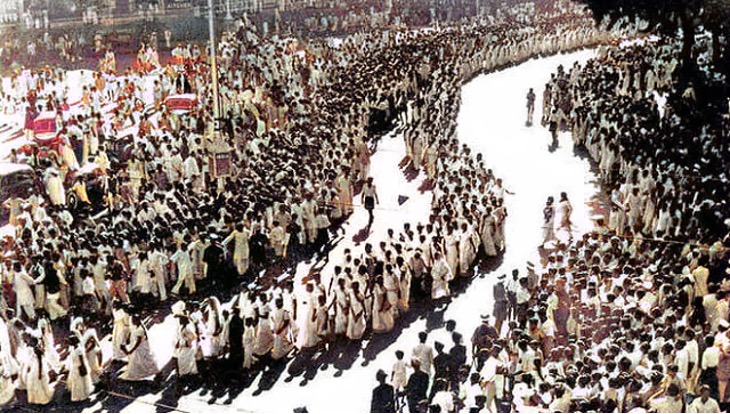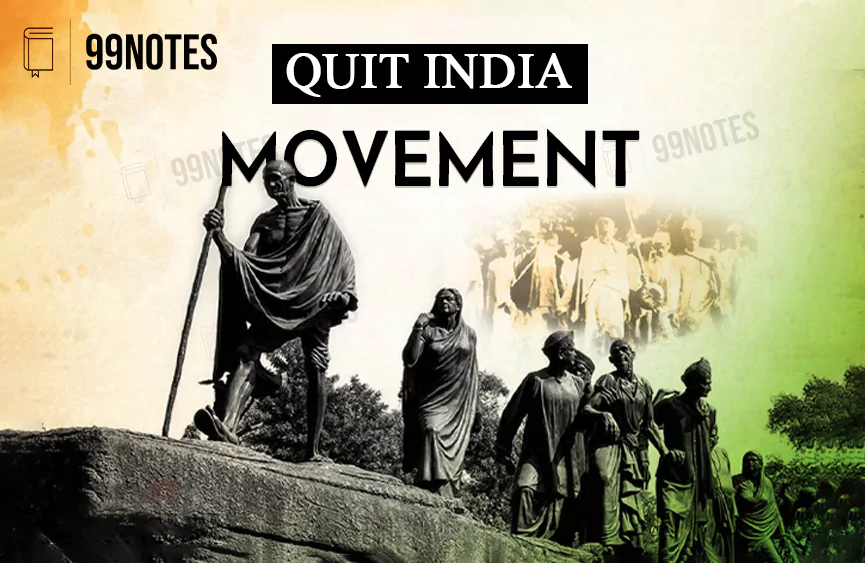Quit India Movement-1942: Causes, Significance, and Impact (Modern History Notes for UPSC)
Quit India Movement (August Kranti)
- Quit India Movement (August Kranti)
- Causes of Quit India Movement
- Reaction of the Government on Quit India Movement:
- Participation in the Quit India Movement
- Distinctive features of the Quit India Movement
- Parallel Governments
- Underground Activities
- Evaluation of the Quit India Movement
- The aftermath of the confrontationist phase
- FAQs related to Quit India Movement
The Cripps mission had failed to pacify the Indians. It made clear that the British were unwilling to concede to any significant demand. Gandhi, who had earlier argued against launching a mass struggle, finally became convinced of the inevitability of a struggle.
Causes of Quit India Movement
Other factors that aggravated the demand of the mass movement are as follows:
- There was discontent in public regarding the rising prices and war-time shortages. The British also appropriated ships and boats in Bengal and Orissa as a preventive action in the wake of a possible Japanese invasion.
- The way the British evacuated from Southeast Asia, rescuing only whites and leaving the subjects to their fate, exposed their racism. Their defeat with the hand of an Asian power shattered their white prestige.
- The national leadership wanted to prepare the masses for a possible Japanese invasion.
The Quit India Resolution
In May 1942, Gandhi declared that he had made up his mind to ask the British to leave India in an orderly manner. Otherwise, he will start civil disobedience.
- The Resolution: In July 1942, the Congress working committee met at Wardha and adopted the ‘Quit India resolution’ authorising Gandhi to take charge of the mass movement. The resolution was to be approved by the AICC meeting in Bombay in August.
- Ratification: On August 8 1942, the AICC ratified the Quit India resolution in its meeting at Gowalia Tank Maidan, Bombay.
Gandhi’s address during Quit India Resolution:
- In his address, Gandhi said, “Nothing less than freedom will be accepted”. Here, he gave his famous mantra, “Do or Die”.
- In his speech, he also gave specific instructions to different sets of people.
- The government servants should not resign but declare their allegiance to the Congress.
- Soldiers should not leave their posts but refuse to fire on their own people.
- The princely states’ rulers should accept their own people’s sovereignty.
- To the subject of the princely states, Gandhi’s message was to declare themselves to be part of the Indian nation and support their ruler if he/she was anti-government.
- Students should give up their studies if they can remain firm till independence is achieved.
- Peasants were asked to pay mutually agreed rent if the Zamindar was anti-government. Otherwise, no tax should be paid.
Reaction of the Government on Quit India Movement:
The government wanted to suppress the Quit India movement for the following reasons:
- The government was ready to crush any movement since the outbreak of the world war itself and was armed with elaborate ordinances since 1940.
- The government had no intention of either negotiating with Congress or waiting for the movement to spread. The possible Japanese aggression also fuelled this determination to suppress the movement.
- Within the hours of the launch of the movement on August 8 1942, the entire CWC leadership was arrested. The next day, Gandhi, Nehru and other leaders of the Congress were arrested. The Congress organisations CWC, AICC and provincial Congress committees (PCCs) were declared illegal, and public assembly was declared illegal under the Defence of India rules.
- The arrest of the top leadership marked the beginning of the movement in different parts of the country.
Spread of the Movement
The impetuous action of the government caused an instantaneous reaction among the people. The countrywide protest started against the British rule as follows:
- Lakhs of people gathered in the Gowalia Tank in Bombay, where a mass meeting had been scheduled, and clashed with the authorities. Similar reactions were seen in Poona and Ahmedabad.
- On August 10, hartals and public demonstrations were organised in defiance of the authorities in several towns of UP and Bihar, including Kanpur, Allahabad, Varanasi and Patna.
- The local Congress leaders who had evaded arrest until now returned to their places and tried to put up resistance.
- Mass upsurge: For the initial few weeks after the launch of the movement, there was a mass upsurge all over the country. The crowds attacked the symbols of authority like police stations, courts, post offices, railway stations, etc. The protestors forcibly hoisted flags on public buildings in defiance of the authorities.
- Large-scale violence: Despite severe repression, the movement only gathered momentum. The movement was particularly violent in eastern UP and Bihar. There were physical attacks on Europeans as well; in Bihar, the villagers killed two RAF pilots, and their bodies were paraded.
Gandhi’s fast
In February 1943, Gandhi declared 21-day fast in his answer to the government, which pressured him to condemn the violence by the people during the movement. Anti-British feelings started to spread in different parts as news of Gandhi’s fast evoked an immediate and overwhelming response from the people as follows:
- There were hartals, strikes and demonstrations all over the country, particularly in Ahmedabad and Calcutta.
- People from all walks of life, including labour movements, students, traders, lawyers, and regular residents, requested his release. Demands for his release were even made in overseas newspapers, parties and organisations.
- The biggest blow to the government came from the three Indian members of the Viceroy’s executive council, M S Aney, H P Mody and N R Sarkar. They had earlier supported the government in its suppression of the movement.
- The British anticipation of Gandhi’s death resulted in disappointment, and the resistance shown by him instead raised public morale and increased anti-British feelings.
Participation in the Quit India Movement
The Quit India Movement was one of the most popular forms of participation in the Indian National Movement. People from different walks of life participated in this movement as follows:
- Youths and students: This section was at the forefront of the movement.
- Women: Women, especially from schools and colleges, played a significant role in the movement. Aruna Asaf Ali, Usha Mehta and Sucheta Kriplani played an active role in underground activities.
- Peasants: Peasants of varying strata were at the centre of the movement. Many Zamindars also took part in the movement. Even the big Zamindars maintained neutrality and refused to assist the authorities in the repression of the movement. There was no anti-Zamindar violence at all.
- Workers: Workers contributed by enduring long periods of strikes and facing severe repression on the streets.
- Officials: The erosion of loyalty towards the government was a striking feature of this movement. The government employees, especially at the lower level of administration, supported the struggle by providing information, shelter and monetary assistance.
- Muslims: Muslim participation was low compared to the previous movements. However, they assisted by providing shelter to the underground workers and did not become informers. There was a total absence of communal violence.
- Communists: The communist party of India did not join the movement. They supported the allied cause when Russia joined the war. However, hundreds of communists participated at the local level despite their party’s official position.
- Muslim League: The League opposed the movement as they wanted a separate nation before the British withdrew from India.
- Hindu Mahasabha opposed the movement on account of internal disorder and internal security issues during the war.
- The Princely states, in general, showed a low-key response.

Repression of the Quit India Movement
The British government took the following steps to suppress the movement:
- The government, armed with Defence of India rules, severely repressed the movement. Although Martial law was not enforced, repression was as severe.
- By the end of 1942, over 60,000 persons were arrested, 26,000 people were convicted, and 18,000 were detained under the Defence of India rules.
- People were taken hostage from the villages, and fines were imposed. There were cases of mass flogging and burning of villages.
- Press freedom was severely restricted.
- It is estimated that nearly 10,000 people lost their lives during the struggle.
Distinctive features of the Quit India Movement
Quit India Movement was different from previous mass movement as it had some distinct features as follows:
Parallel Governments
This was a significant feature of the Quit India Movement. It showed the support of ordinary people towards the indigenous institutions and structure of power. Parallel governments were established in several places in the country.
- Balia: In Balia, in Eastern Uttar Pradesh, a parallel government was formed under Chittu Pandey. While it succeeded in getting several Congress leaders released, it could not survive for long.
- Tamluk (Mahabharata Yuktarashtra: Tamralipta Jatiya Sarkar): The Jatiya Sarkar was established in Tamluk in the Midnapur district of Bengal. It came into existence in December 1942 and lasted till September 1944.
- The Jatiya Sarkar undertook cyclone relief activity, provided grants to schools, supplied surplus rice from the rich to the poor and organised Vidyut Vahini (armed group).
- It could remain for a long due to its remote location.
- Satara: It was the most effective and long-lasting parallel government. Y B Chavan and Nana Patil were the main leaders.
- In 1943, a parallel government or Prati Sarkar was established.
- The movement was involved in the attack on government collaborators, informers, low-level officials and Robinhood-style robberies.
- Nyayadan Mandals were organised to provide justice, Prohibition was enforced, and ‘Gandhi marriages’ (inexpensive and invitation to untouchables) were organised.
- The parallel government continued to function till 1945.
- Other parallel governments included the ‘Azad Government’ in Ahmedabad and one formed by Rammanohar Lohia on the Nepal border.
Underground Activities
- The brutal suppression of the movement brought out the cooling down of the mass phase of the struggle within a period of six to seven weeks of the launch. Meanwhile, an underground network was being consolidated in the various parts of the country.
- The Congress Socialists generally led the activities, but Gandhi Ashramites, members of the forward bloc and revolutionaries were also involved. These activities were active in the regions of Maharashtra, Gujarat, Kerala, Andhra, UP, Bihar and Delhi.
- The leaders involved in this network were Ram Manohar Lohia, Aruna Asaf Ali, Achyut Patwardhan, Sucheta Kriplani, Biju Patnaik, R P Goenka, Jai Prakash Narayan and others.
- The underground activities involved the disruption of communications by blowing up bridges, cutting telegraph and telephone wires and derailing trains. There were also some instances of attacks on police and informers.
- Dissemination of information was an important part of underground activities. In Bombay, Congress Radio was being operated by Usha Mehta, whose broadcast could be heard as far as Madras.
- The underground activities were crucial in maintaining the people’s morale and providing guidance and leadership to activists across the country. They also facilitated the movement of money and arms to the activists.
- The underground activists received support from a large section of people. Businessmen donated generously to the cause, students acted as couriers, and Government employees were also involved in the movement of materials and passing information.
Evaluation of the Quit India Movement
- Element of spontaneity: The movement had more spontaneity than previous mass struggles.
- The primary reason could be the absence of top leadership. Even the broad programmes were not clearly spelt out, and the movement was yet to be formally launched.
- Some degree of spontaneity was sanctioned by the leadership in the AICC resolution of August 8 2022.
- Most violent Gandhian Movement?
- There were many people in the Congress, including some staunch Gandhians, who believed that the peculiar circumstances warranted the use of violence.
- Some believe that there is nothing wrong with sabotaging communication lines or blowing up bridges if it does not cause loss of human life.
- Gandhi refused to condemn the violence by the people as he argued that it was a reaction to much bigger violence by the state.
- Scholars view Gandhi’s insistence on non-violence as a means to increase the participation of the masses in the struggle, but in 1942, when violence did not seem to restrict mass participation, Gandhi refused to condemn it.
- Less conservative: The absence of the political elite in the forefront is why the movement was less conservative.
- The movement was in the hands of the subaltern class.
- It was the most radical and violent of all the previous struggles.
- Unlike the previous movements, which were more prominent in urban areas, this time, the labour class and poor, who were hit hardest by the rising inflation and food shortage, participated enthusiastically.
- Independence was no longer a matter of bargain: The Quit India Movement made the demand for complete independence the immediate agenda of the movement. After this, there was no turning back, and future negotiations with the British would involve nothing less than complete independence.
The aftermath of the confrontationist phase
- Political activity resumed after the release of Gandhi in May 1944 on medical grounds.
- The Congress began with constructive work with special emphasis on reorganising the party.
- While the government remained watchful of the Congress’s activity, it did not take any repressive action.
- The release of the Congress leaders to participate in the Simla Conference (Wavell offer) ended the confrontationist phase of the struggle.








